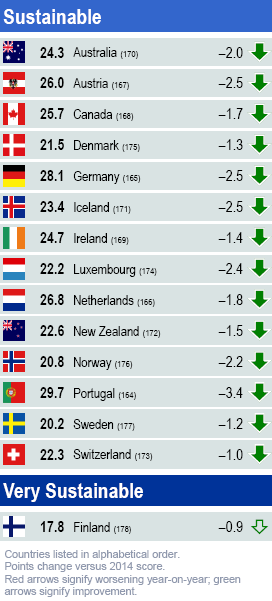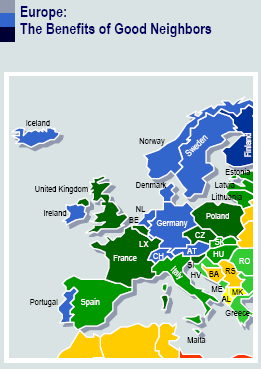BY HANNAH BLYTH AND J.J. MESSNER

Every year, the most stable end of the Fragile States Index appears to tell a familiar story. Since the Fund for Peace began assessing all major countries in 2006, Scandinavia has held a near-monopoly on the least fragile end of the Index.
It comes as no surprise that once again, 2015 saw the four main Nordic countries come away with the best Index scores. The Nordic Model has garnered praise over the past two decades for its unique mix of social welfare and economic efficiency. This benchmark of a happy, healthy and productive populace amongst Denmark, Norway, Sweden and Finland, has proven not only to work, but is sustainable.
Despite many misconceptions about the Scandinavian big-spending socialist welfare state, the Nordic countries have long ago left behind their high public spending and taxation rates of the 1970s and 1980s. They have now emerged in the twenty-first century as lean, green innovators and entrepreneurs with low budget deficits and corporate tax rates well below those of the United States. The Nordic states enjoy high levels of transparency within public institutions and government, with their Index scores for State Legitimacy, Human Rights and Factionalized Elites all remaining impressively low. Finland for example, received high praise from the International Monetary Fund in its 2015 Fiscal Transparency Evaluation, while Sweden continues to pride itself on its long standing legacy of granting public access to office documents under the Freedom of the Press Act. Social equality, high female workforce participation, robust functioning democratic institutions and press freedom are just a few more commonalities which have helped the Nordic four remain some of the least fragile countries.
However in spite of this high praise, as we look beyond 2015 the Nordic states must avoid the trappings of Group Grievance. The rise of ultra-nationalist right party politics in Europe – including the anti-immigration Sweden Democrats, the country’s third largest party – has the potential to undermine the egalitarian social fabric of the Scandinavian countries. If the Nordic four are to remain the celebrated models of state sustainability, they must ensure their model of inclusive and prosperous stable society remains open to all.
European Countries Continue to be High Achievers

This year, we celebrate the 70th anniversary of the end of World War II, and in doing so it is important to acknowledge just how far Europe has come in that time. Of the 15 Sustainable or Very Sustainable countries on the Fragile States Index, 12 are European. Expand that to include the More Stable category as well, and that ratio becomes 18 European countries out of 26. As Europe has integrated further and further, politically and economically (and, for anyone who has witnessed the Eurovision Song Contest, apparently culturally as well), the continent has become increasingly stable and sustainable. Indeed, all of those 18 European countries improved even further, year-on-year in 2015.
Further east, even despite conflict in the 1990s, three of the seven former Yugoslav states are among the seven most improved countries in the past decade in the world. With the exception of Hungary and Ukraine, every European country in the former Communist bloc has improved — many significantly — in the past decade. It is highly likely that much of this improvement has been helped by location, situated in a region of other stable countries where stability begets stability.
But the continuing Greek economic crisis, as well as the rise of far right parties in multiple European countries demonstrates that stability cannot be taken for granted. For now at least, it is worth recognizing the good news that the Fragile States Index can tell us.
